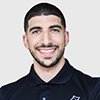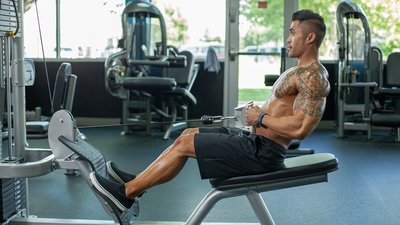Lifters like to talk about the "mind-muscle connection" like it's some kind of mystical state that we should all aim for, elusive and unknowable. The truth is that it can be easily measured, by looking at muscle activation differences between different technique cues. And sometimes, finding it easier than you might think!
I'm one of those lucky lifters who is also a researcher with scientific equipment at my disposal. As part of my master's studies in the Human Performance Lab at the University of Tampa (Florida), I’ve been researching how using the mind-muscle connection can improve bodybuilding movements.
My specific goal was to find a way to maximize lat activation during horizontal rowing movements and then build a mental cue to trigger proper muscle recruitment. I found that once I was better able to "connect my mind to my lats," my progress really took off.
The Normal Row vs. the Depressed Row
One challenge for many trainees is how to best execute their rows to target all the muscles they want without letting other muscles hijack the move. Specifically, it's common for the rhomboids, traps, and rear delts take over the movement, leaving the lats relatively unengaged. This happens when you simply bring your elbows as far behind you as possible and pinch your shoulder blades together.
Yes, this method does provide the greatest mechanical advantage—meaning you can pull the most weight—and it definitely hits some important muscles. But my goal here was specifically to maximize lat engagement. To do that, I had to develop a motor pattern that's a bit different from how we normally perform rows.
After some experimentation, I discovered that the most effective way to increase lat engagement was to simply depress the shoulder blades or scapula before starting the row and maintain that depressed position throughout the set. It's a simple change, but it makes a huge difference in lat recruitment, particularly for the lower lats.
Here's why it works: Certain lat fibers originate at the inferior angle of the scapulae, which enables them to play a large roll in depressing the shoulder blades. When you initiate the rowing movement with your shoulder blades in this depressed position, you put those lat fibers into a contracted position. With each row, the fibers move from this fully contraction position to full extension, which leads to maximum activation.
The trick is to keep your shoulder blades depressed throughout the movement. I help my clients do this by having them imagine trying to scrape their elbows across the floor as they row back and forth. This visualization really drives home the motor pattern and get the lats firing!
And by increasing the muscle activation of my lats, I'm also providing them with mechanical-tension overload—which, in turn, significantly increases their growth potential. If that's your goal, give this technique a try!

